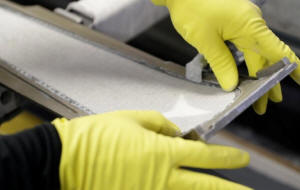|
Faster, lighter, springier: the quest for the perfect ski
 Send a link to a friend
Send a link to a friend
 [January 02, 2018]
By Leonhard Foeger and Mark Trevelyan [January 02, 2018]
By Leonhard Foeger and Mark Trevelyan
ALTENMARKT, Austria (Reuters) - It is
not just American hopes that will be riding on the performance of
Mikaela Shiffrin when the world's top woman alpine skier takes to
the slopes at the Winter Olympics in South Korea next month.
Half a world away in the small Austrian town of Altenmarkt, the
marketing and tech teams at ski manufacturer Atomic will be closely
watching the medal count in Pyeongchang, the culmination of about 18
months of internal company planning.
Of 900 staff based at the company south of Salzburg, 38 are part of
a team of international specialists, whose job is to develop
ever-sleeker and more manoeuvrable skis for everything from racing
to backcountry touring.
Whereas in the early 1990s design was revolutionised by switching
from long, straight racing skis to a side-cut 'parabolic' shape, and
later shifts focused on the camber, or arch, of the ski, the trend
in recent years has been towards more advanced materials such as
titanium.

Atomic General Manager Wolfgang Mayrhofer said the thinner, less
dense materials, including lighter wood cores, and the deeper
sidecuts permitted under new giant slalom rules have made a big
difference to the skis.
"The skis are easier to turn," said Austria's Marcel Hirscher, the
six-times overall World Cup champion who is bidding for his first
Olympic gold medal in Pyeongchang.
"But now with the new materials they can ski different lines, they
keep the same stability and rigidity but they are much more
flexible, much more dampening.
"So it's big progress since the Sochi days, since the last
Olympics."
HEAD TO HEAD
In the speed events of downhill and super-G there has been no
fundamental change to ski design in the past 10 years, according to
Matt Humphreys, winter sports boss at HEAD UK, but new materials
have changed their composition.
Austria-based HEAD, whose skis are used by Olympic champions Lindsey
Vonn, Ted Ligety, Kjetil Jansrud and Aksel Lund Svindal, have said
it is the only manufacturer to incorporate graphene, a super-thin,
super-strong form of carbon that was isolated by scientists only in
2004.
The point is not to make racing skis lighter, as a heavier ski
provides more stability for a downhill racer hitting speeds around
90 miles/hour (145 km/h) but to improve the flexibility and the
distribution of power.
"With us using graphene, we can get the flex pattern exactly how we
want it to be ... the more we put in, the stiffer and stronger the
ski becomes," said Humphreys.
That cutting edge design does not end with the ski.

[to top of second column] |

An employee prepares an Atomic ski on the production line at the
company's headquarters in Altenmarkt im Pongau, Austria November 28,
2017. REUTERS/Leonhard Foeger

Minute, detailed effort goes into the fit and comfort of boots as
well as their 'canting' - the slight inward- or outward-tilting
angle of the shoe that is tailored to match the angle of the skier's
knees.
"Where we try and get ahead of the game is with some of our top
athletes," Humphreys said.
"We do have casts of their feet and their lower legs so we can work
on them in terms of pressure points and customisation without the
athlete having to be there."
DEMANDING ATHLETES
For Atomic, their top athletes are local product Hirscher, who lives
close to Altenmarkt, and Shiffrin, who won the slalom gold in Sochi
and became the overall World Cup women's champion this year.
"I started skiing on Atomic when I was 12 and have skied Atomic
skis, boots, and bindings since then," the American told Reuters.
"It was just a natural progression for me to stick with the skis
that I had been so confident on as I started racing on the World
Cup."
Atomic, like the other manufacturers HEAD and Frances' Rossignol,
send their technical experts to accompany the top racers at every
event, working closely with their coaches and national federations,
to tune and service their gear like a Formula One team to suit the
conditions.
"They're athletes, they're champions, they're demanding," Mayrhofer
added.
"Therefore you need a team. For Hirscher, for Shiffrin you have a
dedicated team with ski makers, boot specialists, you have all the
experts there."
With the event now in sight, Mayrhofer said he felt quietly
confident all of their planning would pay off.

"I have a good feeling we are nicely prepared. I feel good we will
have everything we need," he said. "Then it's always (necessary) of
course to be a bit lucky also.
"But we have great athletes, we have all the stuff together which is
needed to win."
(Reporting by Leonhard Foeger from Altenmarkt and Mark Trevelyan
from London; additional reporting by Rory Carroll; Editing by Greg
Stutchbury)
[© 2018 Thomson Reuters. All rights
reserved.] Copyright 2018 Reuters. All rights reserved. This material may not be published,
broadcast, rewritten or redistributed. |